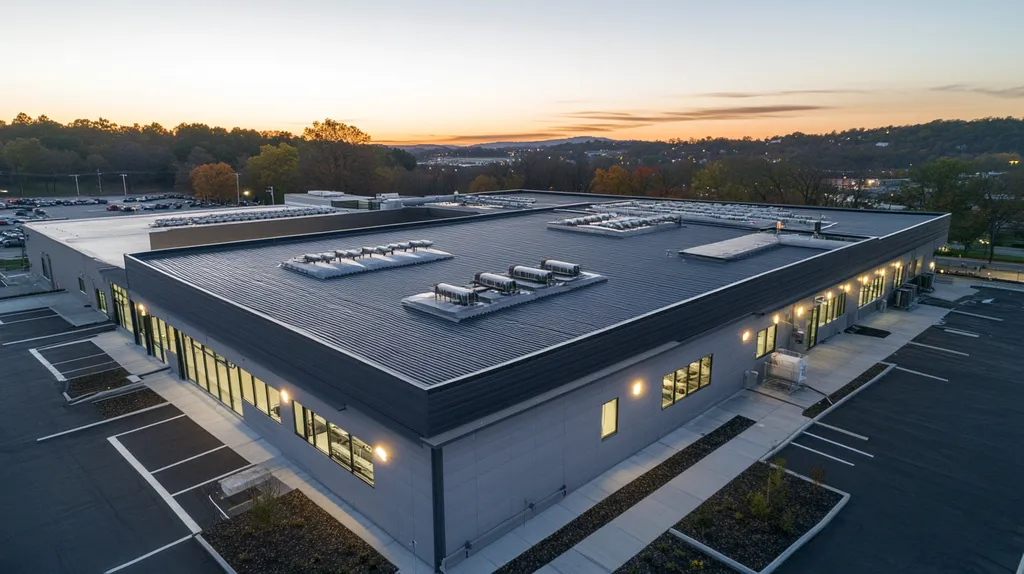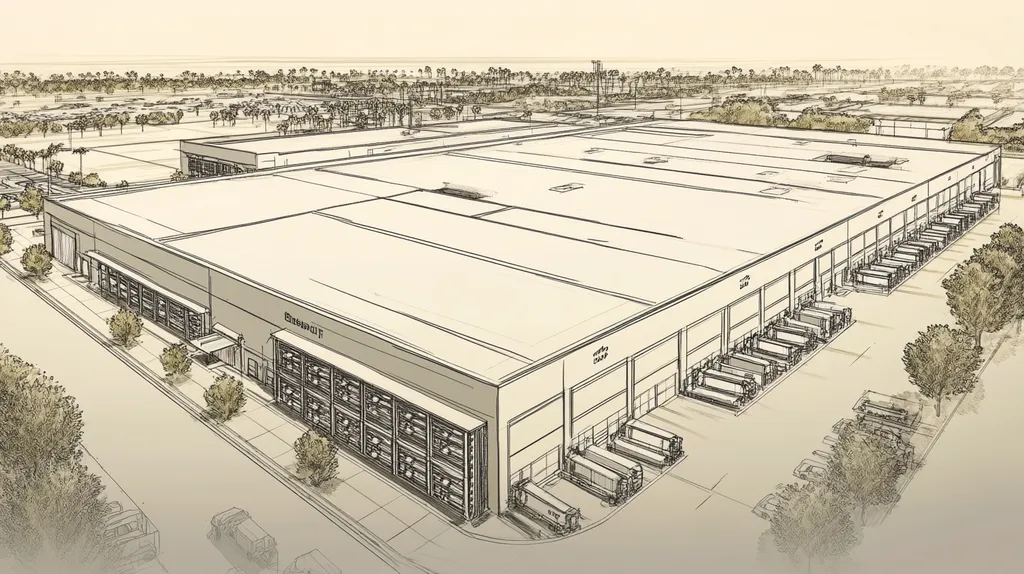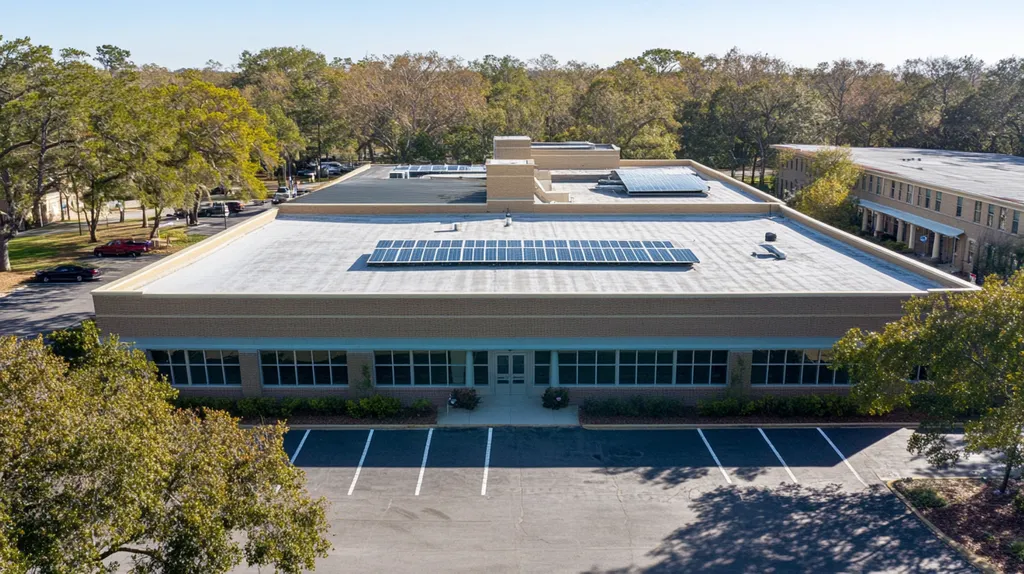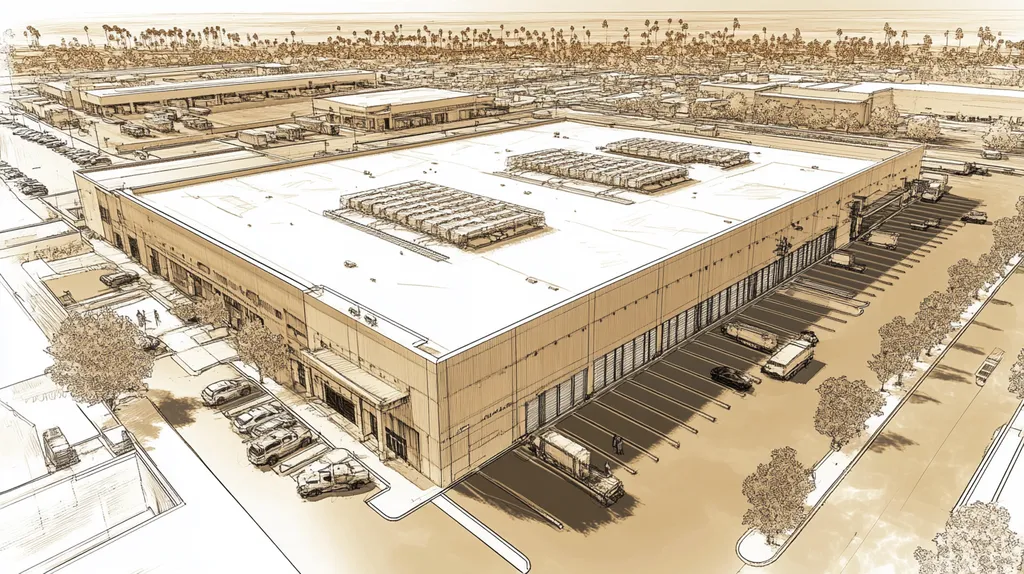In the high-stakes world of cold storage facilities, where a single degree of temperature variation can lead to millions in losses, traditional roofing solutions are falling dangerously short. Industry data reveals that up to 40% of cold storage energy waste stems from inadequate roof systems and coatings.
While conventional wisdom has long favored familiar materials like built-up roofing (BUR) and single-ply membranes, mounting evidence suggests these “tried-and-true” solutions may be freezing progress in its tracks.
This analysis challenges established cold storage roofing practices, examining how innovative coating technologies and installation methods could revolutionize facility performance while driving down mounting operational costs.
SECTION 1: CURRENT PRACTICES
As cold storage facilities strive to maintain ideal conditions, the crucial role of dependable roofing cannot be emphasized enough. Outdated roofing materials create not only costly energy inefficiencies but also the risk of product spoilage. A startling statistic reveals that a significant 30% of cold storage energy costs can be traced back to ineffective roofing solutions. This section delves into the standard roofing materials currently in use, explores common installation practices, and reviews maintenance routines that are ripe for reevaluation.
Standard Roofing Materials Used
Many cold storage facilities cling to traditional roofing materials such as built-up roofing (BUR) and single-ply membranes. The BUR systems, with their long history, often struggle with thermal expansion issues that can compromise their structural integrity over time. Single-ply membranes, like TPO and PVC, while also common, may fall short in providing the robust insulation needed for extreme temperature control.
Insulation is essential in these environments, as subpar thermal performance can spike energy costs. The Department of Energy highlights that inadequately insulated roofs can waste 20-30% more energy compared to their well-insulated peers. This acceptance of conventional materials jeopardizes the overall efficiency of cold storage operations.
Surprisingly, innovative options such as liquid-applied elastomeric coatings aren’t widely embraced yet. Despite their potential for superior thermal insulation and waterproofing benefits, many facility managers hesitate to make the switch. This reluctance can stifle both operational performance and sustainability efforts in these vital sectors.
Failing to adopt materials that boost energy efficiency and insulation could lead cold storage facilities to face formidable long-term challenges. Grasping the limitations of existing materials is key to recognizing the urgent need for innovation in roofing solutions.
Common Installation Methods
Installation methods for conventional roofing systems within cold storage units vary widely but often include lackluster techniques that neglect energy efficiency. For instance, BUR installations involve labor-intensive processes with multiple layers of asphalt and felt, resulting in longer installation times and extended exposure to the elements, which can undermine the roof’s longevity.
While single-ply membranes boast a relatively simpler installation, they still struggle with seams that may not be adequately sealed. These failures can lead to leaks that jeopardize temperature controls. Moreover, many installation teams often skip necessary insulation upgrades during renovations, inadvertently diminishing the roof’s overall effectiveness.
Some facilities resort to “quick fixes,” patching over visible issues instead of addressing more profound, underlying problems. This approach can trap facilities in a relentless cycle of repairs that increase expenses and hamper storage capacity. Although industry standards advocate for comprehensive assessments before embarking on any roofing work, it’s a practice frequently overlooked.
Effective installation should prioritize long-term solutions instead of settling for mere short-term fixes. Embracing more modern installation methods, including reflective coatings, can enhance performance while simultaneously trimming lifetime costs.
Typical Maintenance Routines
The maintenance routines for cold storage roofs often reflect a reactive mindset. Many facility managers find themselves waiting for leaks or substantial damage before taking action, bypassing the benefits of a proactive maintenance schedule. This procrastination can expose fixtures to moisture and temperature fluctuations that threaten product quality.
Standard maintenance usually entails periodic inspections, often made just once or twice a year. These inspections may focus predominantly on visible issues, such as debris buildup or surface cracks, without investigating deeper, potential concerns. Neglecting to address these issues early can allow them to fester, leading to major complications down the line.
Regrettably, some facilities underestimate the critical role regular cleaning plays in maintenance routines. Removing debris and standing water is vital in preserving roof integrity, particularly in cold storage settings where condensation can create dangerous conditions. Allowing inadequate cleaning can significantly shorten the lifespan of roofing materials.
Enhancing maintenance routines to include regular assessments of thermal insulation quality and material integrity can substantially elevate overall performance. Transitioning to a more systematic approach, which incorporates newer technologies and coatings, will bolster resilience in cold storage environments.
SECTION 2: SYSTEMIC ISSUES
Cold storage facilities grapple with a host of roofing challenges, where the stakes couldn’t be higher. A single leak or inadequate insulation can precipitate costly losses, endangering precious inventory. Condensation issues can arise from improper roofing techniques, creating a perfect storm for product spoilage. This section shines a light on critical systemic problems affecting cold storage roofs, including condensation and vapor drive, insulation efficiency gaps, and air movement and moisture concerns.
Condensation and Vapor Drive Problems
Condensation is the stealthy intruder in cold storage facilities. When warm, moist air collides with cold roofing surfaces, moisture seeps in, risking damage to stored products.
Often, traditional roofing systems exacerbate vapor drive issues. They may lack ironclad barriers that manage moisture movement, leading to dangerous pooling and unavoidable leaks.
Over time, this trapped moisture doesn’t just evaporate; it fosters the growth of mold, jeopardizing both product quality and health standards.
To fend off these challenges, property owners must invest in effective vapor barriers within their roofing systems. Neglecting this crucial aspect could translate to long-lasting financial setbacks.
Insulation Efficiency Gaps
When it comes to cold storage, insulation is the unsung hero that keeps everything running smoothly. However, many facilities find themselves wrestling with insulation efficiency gaps.
When insulation falls short, heat transfers in, forcing cooling systems to work overtime, which directly inflates energy costs.
Moreover, unpredictable temperature swings can compromise the integrity of stored products. For businesses dependent on strict temperature controls, maintaining the highest insulation standards is a must.
Utilizing advanced insulation materials and techniques is crucial for closing these gaps. Not only does this safeguard product quality, but it also helps keep operating costs in check.
Air Movement and Moisture Issues
Air movement is another critical factor plaguing cold storage roofing systems. Insufficient ventilation can lead to stagnant moist air, setting the stage for condensation to thrive.
Weather events can surprise facility owners by introducing unexpected moisture loads, challenging even the most robust roofing systems.
Properly assessing air movement patterns is essential when designing and maintaining roofs. Investing in effective ventilation solutions can significantly reduce these risks.
By incorporating innovative engineering methods, facilities can enhance overall roof performance and extend the lifespan of cold storage roofs. A forward-thinking approach is imperative in the face of ever-changing environmental conditions.
SECTION 3: MISSED OPPORTUNITIES
In an era where energy efficiency is paramount, cold storage facilities find themselves at a critical crossroads. Sticking to outdated roofing practices not only stifles performance but also inflates operational costs. Embracing advancements in insulation, installation techniques, and automation is not just wise; it’s essential. These missed opportunities for innovation could dramatically influence the efficiency and longevity of industrial roofing systems.
Advanced Insulation Innovations
The continued reliance on traditional insulation materials in cold storage facilities creates significant hurdles. New insulation technologies like vacuum insulation panels and spray foam present exciting opportunities for energy savings. These advanced materials offer superior thermal resistance, radically decreasing energy consumption while enhancing temperature control.
Consider vacuum insulation panels; they deliver R-values far superior to standard fiberglass insulation. This innovation leads to notable savings on heating and cooling costs over time, with facilities that adopt these materials likely experiencing a return on investment through lower energy bills and an extended roof lifespan.
Moreover, reflective insulation can minimize heat absorption, making it especially advantageous in environments with fluctuating temperatures. By embracing such cutting-edge insulation, property owners not only boost the energy efficiency of their cold storage roofs but also position themselves as leaders in an increasingly eco-conscious market.
Efficient Installation Techniques
The installation methods for cold storage roofs are lagging behind technological advancements, leaving many facilities at risk. Traditional techniques often introduce errors and inefficiencies that compromise both performance and safety. Innovative solutions like modular roofing systems have emerged, streamlining the installation process and significantly reducing both labor costs and installation time.
Imagine using pre-fabricated roofing components that can be swiftly assembled on-site, minimizing disruption to cold storage operations. This efficiency not only saves valuable time but also mitigates the likelihood of mistakes that often occur with conventional installation methods.
Additionally, improving training for roofing professionals ensures that these advanced techniques are executed correctly. Facilities adopting these modern installation methods can anticipate fewer maintenance issues, culminating in a longer service life for their roofing systems, and resulting in measurable benefits for cold storage operations.
Integration of Automation and Technology
The cold storage industry is poised for a revolution through the integration of automation and smart technology into its roofing solutions. Automated monitoring systems can continuously track roof conditions, alerting facility managers to potential problems before they escalate into costly repairs. This proactive approach safeguards the roofing life, bolstering efficiency across operations.
Sensors capable of detecting temperature fluctuations, moisture levels, and structural integrity provide invaluable insights. With this data, property owners can make informed maintenance decisions, averting unexpected downtimes and preserving product integrity.
Moreover, utilizing drones for roof inspections accelerates the assessment process, allowing for quicker reactions without putting workers at risk. By embracing automation, the cold storage sector can enhance operational efficiency, boost safety, and ensure top-notch care for their roofing systems, creating a ripple effect of improvements throughout the industry.
SECTION 4: ROOT CAUSES
The effectiveness of cold storage roofing systems often falters due to a blend of fundamental oversights. Many property owners overlook how design flaws can lead to considerable thermal inefficiencies. An eye-opening 30% of energy costs in cold storage facilities can be traced back to roofing issues. This stark reality underscores the urgency in choosing the right materials and installation practices. By addressing inadequate design considerations, poor material selection, and suboptimal installation, property owners can significantly boost operational efficiency and shrink long-term costs.
Inadequate Design Considerations
The design phase of a cold storage roof is often rushed or poorly executed. Many designs fail to factor in the specific thermal requirements essential for cold storage facilities. This oversight results in roofs that inadequately insulate or ventilate, contributing to spoiled products and soaring energy bills.
For instance, a poorly designed roof lacking sufficient insulation can lead to heat transfer that forces refrigeration systems to work overtime. This not only increases operational costs but can also lead to frequent breakdowns and costly repairs. Without proper drainage solutions, water can accumulate, risking both roof integrity and structural damage over time.
Mismatched roof slopes can exacerbate water pooling issues, posing immediate threats during thaw cycles. Implementing a comprehensive design review process can help circumvent these costly blunders and ensure the roof operates efficiently.
Ultimately, a well-crafted design is more than just a visual choice; it is critical for the longevity and overall effectiveness of cold storage operations.
Poor Material Selection
Choosing the right materials is vital for cold storage roofing, yet many property owners stick with conventional options without considering their drawbacks. Traditional materials may falter under the thermal stress of fluctuating temperatures typical in cold storage settings.
For example, using standard asphalt-based membranes can lead to premature degradation, paving the way for leaks and escalating maintenance costs. In contrast, specialized coatings designed to endure thermal expansion and contraction can significantly prolong the roof’s lifespan.
Moreover, overlooking moisture resistance when selecting materials can lead to long-term damage. Subpar materials may foster mold and mildew, threatening not only the roof’s integrity but also the entire stored inventory. Opting for materials specifically engineered for cold storage applications can greatly mitigate these risks.
Investing in the right materials from the outset yields significant cost savings and operational efficiency down the line, making it crucial for preserving product quality.
Suboptimal Installation Practices
Even with a solid design and appropriate materials, the installation process can undermine a roof’s performance. Many roofing contractors lack the necessary experience with cold storage systems, leading to improper installation techniques that create vulnerabilities.
For instance, inadequate sealing of seams can cause air leaks, leading to temperature fluctuations that jeopardize stored goods. Furthermore, improperly applied coatings can fall short in protecting against the harsh demands of cold storage.
Training in specialized installation practices is often overlooked, leaving contractors unaware of important nuances specific to cold storage applications. This knowledge gap can lead to issues such as poor adhesion and misalignment, which can invite premature wear and tear.
Establishing a rigorous quality assurance process during installation is crucial. This practice ensures that best methods are applied, reducing the likelihood of costly repairs and extending the roof’s service life.
DATA DRIVEN EVIDENCE
In the fast-paced world of cold storage facilities, choosing the right roofing materials is not just about aesthetics; it’s a matter of survival. Traditional roofing options can dramatically inflate energy bills, with some facilities wasting as much as 30% more energy due to outdated thermal insulation. As energy costs rise and regulations tighten, property owners and facility managers must urgently reassess their roofing strategies. This section explores essential metrics on energy efficiency, condensation risks, and cost comparisons to shed light on the compelling need for modern roofing solutions.
Energy Efficiency Metrics
Energy efficiency is a game-changer for cold storage operations. Research indicates that roofs featuring reflective coatings can slash energy consumption by as much as 20%, a significant boost during scorching peak temperatures. Traditional materials often provide insufficient insulation, leading to temperature swings exceeding 20°F, which places more strain on refrigeration systems.
Coatings specifically designed for colder climates can stabilize indoor temperatures, resulting in lower energy bills and a stronger bottom line. Moreover, energy-efficient roofing solutions often qualify for rebates, making them not just smart but also economically savvy. The data overwhelmingly supports one conclusion: upgrading roofing technology is essential for curbing costs and enhancing performance.
Condensation and Mold Statistics
Condensation can wreak havoc in cold storage environments, jeopardizing product integrity and fostering mold growth. Alarmingly, about 40% of facilities report mold problems stemming from condensation linked to traditional roofing systems. Utilizing high-quality thermal insulation along with specialized coatings can reduce the risk of condensation by nearly 50%, ensuring both product safety and a healthier workspace for employees.
The financial dents caused by mold remediation can run into the thousands, underscoring the urgency for effective roofing solutions. Facilities that invest in modern coatings not only protect their products but can also significantly lower maintenance expenses. Success stories show that businesses employing reflective coatings face fewer humidity-related problems, resulting in greater operational stability.
Cost Analysis of Current Practices
Worries about the initial costs of advanced roofing materials often hinder investment. However, a thorough cost analysis reveals that long-term savings can overshadow initial expenditures. For instance, facilities that upgrade to high-performance coatings frequently observe energy savings that allow for a payback period of just 3-5 years.
Additionally, traditional roofing systems usually come with hefty maintenance bills, with some facilities allocating as much as 15% of their budgets to repairs. Transitioning to roof coatings that require less frequent upkeep can significantly cut these recurring costs. Not to mention the potential revenue loss due to operational disruptions from roof failures. By considering these potential hidden costs, businesses can see that investing in better roofing solutions makes sound financial sense.
In conclusion, a well-rounded cost analysis illustrates that investing in advanced coatings is not merely a financial burden; it is a strategic initiative that aims for improved efficiency and durability.
SECTION 6: ALTERNATIVE SOLUTIONS
As the demand for efficient cold storage solutions surges, the shortcomings of traditional roofing systems can no longer be ignored. Property owners are grappling with soaring costs and operational risks linked to outdated materials. Thankfully, embracing high-performance roofing systems, optimized insulation, and advanced coating technologies can markedly enhance energy efficiency while extending roof lifespan. This section delves into these innovative options that are designed to meet the pressing needs of cold storage facilities.
High-Performance Roofing Systems
High-performance roofing systems are built to tackle the distinctive challenges found in cold storage environments. These systems utilize cutting-edge materials that combine exceptional durability and insulation properties. By minimizing thermal bridging, they promote energy efficiency and help maintain stable internal temperatures.
For example, insulated metal panels are superb at resisting moisture—one of the most common issues in cold storage. Such roofs not only reduce the chances of leaks but also cut down on energy consumption required for temperature regulation. While the initial investment in high-performance materials may be higher, it often leads to significantly lower long-term operational costs.
Moreover, these systems can be integrated with existing roofing structures, simplifying the retrofit process. This feature is especially advantageous for facilities aiming to modernize their roofs without the hassle of a full replacement. Ultimately, these roofs contribute to improved operational efficiency across the board.
Optimized Insulation and Barrier Use
Optimized insulation and barrier systems can dramatically enhance temperature regulation in cold storage facilities. Many property owners underestimate the importance of high-quality insulation, resulting in energy losses and compromised product integrity. By investing in advanced insulation materials, facilities can better maintain internal temperatures, especially in extreme climates.
Reflective barriers are particularly essential in regions experiencing fluctuating temperatures. They help reduce heat gain during warmer months and foster thermal stability, keeping energy costs under control. Utilizing multiple layers of insulation can also prevent condensation and diminish the risk of mold, safeguarding valuable inventory.
By prioritizing optimal barrier construction, property owners can achieve substantial energy savings while ensuring their roofs effectively support consistent temperature management.
Advanced Coating and Sealing Technologies
Advanced coatings and sealing technologies are transforming the landscape of cold storage roofing. These products not only bolster a roof’s resistance to the elements but also include reflective properties that can diminish heat absorption, leading to significant cooling cost reductions.
For instance, elastomeric coatings possess the ability to expand and contract with temperature changes, ensuring a waterproof seal that protects against leaks. Additionally, re-coating existing roofs can prolong their lifespan by addressing the wear and tear that accompany aging materials. Many facilities overlook these advanced technologies, thus missing out on essential performance upgrades.
Furthermore, the efficient application techniques associated with these coatings result in minimal operational downtime. This allows facilities to maintain functionality during upgrades, making it a practical choice for busy cold storage environments. By embracing these innovative solutions, property owners can ensure enhanced performance and encouraging long-term cost reductions.
Looking Ahead
The cold storage industry stands at a critical inflection point, with up to 40% of facilities still relying on outdated roofing technologies that hemorrhage energy and compromise product safety.
Advanced coating solutions, from elastomeric membranes to reflective barriers, offer transformative potential to slash energy costs by 20-30% while extending roof lifespans by decades.
The data is clear: facilities that embrace these innovative coating technologies consistently outperform their peers in energy efficiency, maintenance costs, and operational reliability.
As environmental regulations tighten and energy costs continue to rise, the question is no longer whether to upgrade cold storage roofing systems, but how quickly facilities can implement these essential improvements.
The future of cold storage depends on leaving outdated roofing practices in the past where they belong.
FREQUENTLY ASKED QUESTIONS
Q. What current practices affect commercial roof efficiency in cold storage?
A. Current practices often rely on outdated roofing materials like BUR and single-ply membranes, leading to energy inefficiencies. These materials struggle with thermal expansion, making cold storage less effective and wasting energy. Additionally, common installation methods can exacerbate these issues, causing leaks and higher repair costs.
Q. How do systemic issues influence industrial roof performance?
A. Systemic issues like condensation and vapor drive create significant challenges for industrial roofs. Moist warm air meets cold surfaces, causing leaks and product spoilage. These problems occur due to inadequate vapor barriers and insulation that elevate maintenance costs and jeopardize inventory quality.
Q. What missed opportunities exist for commercial roof enhancements?
A. Many facilities miss opportunities to adopt advanced insulation technologies and efficient installation techniques. Sticking to outdated materials not only inflates energy costs but can also lead to operational hiccups. Embracing innovations such as modular roofing and automation fosters long-term savings and improved overall efficiency.
Q. What root causes contribute to poor industrial roof performance?
A. Root causes include inadequate design considerations and poor material selection, which lead to thermal inefficiencies. Many roofing systems are designed without factoring in the specific needs of cold storage. Such oversights result in wasted energy, increased operational costs, and compromised product quality.
Q. What data-driven evidence supports roofing system upgrades?
A. Data shows that outdated roofs can waste as much as 30% energy, driving up costs. Facilities using reflective coatings see energy savings of up to 20%, validating the need for modern roofing solutions. Investing in better materials may also reduce maintenance costs and energy consumption significantly.
Q. What alternative solutions can improve commercial roofs?
A. High-performance roofing systems, optimized insulation, and advanced coating technologies are critical alternatives. These solutions enhance energy efficiency and can significantly extend roof lifespan. Investing in innovative materials fosters better temperature control, most importantly in environments with demanding cold storage conditions.
Q. What are the latest trends in commercial roofing for cold storage?
A. Recent trends include adopting smart technology for monitoring roof conditions and functionality. Integrating automation for predictive maintenance helps prevent issues before they escalate. Additionally, reflecting coatings and advanced insulation solutions are gaining traction for energy efficiency and longevity in cold storage environments.










